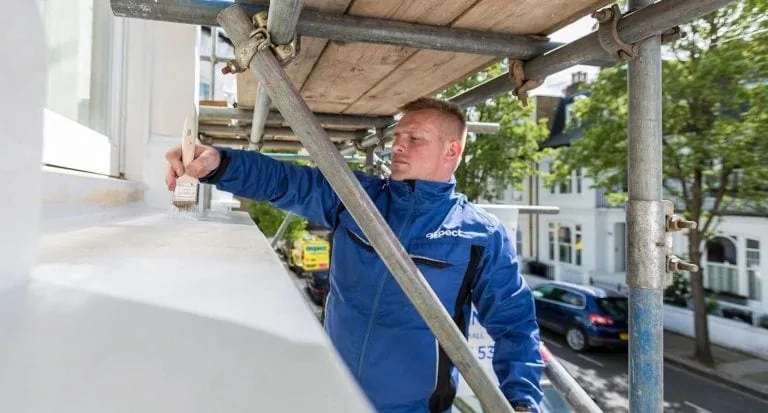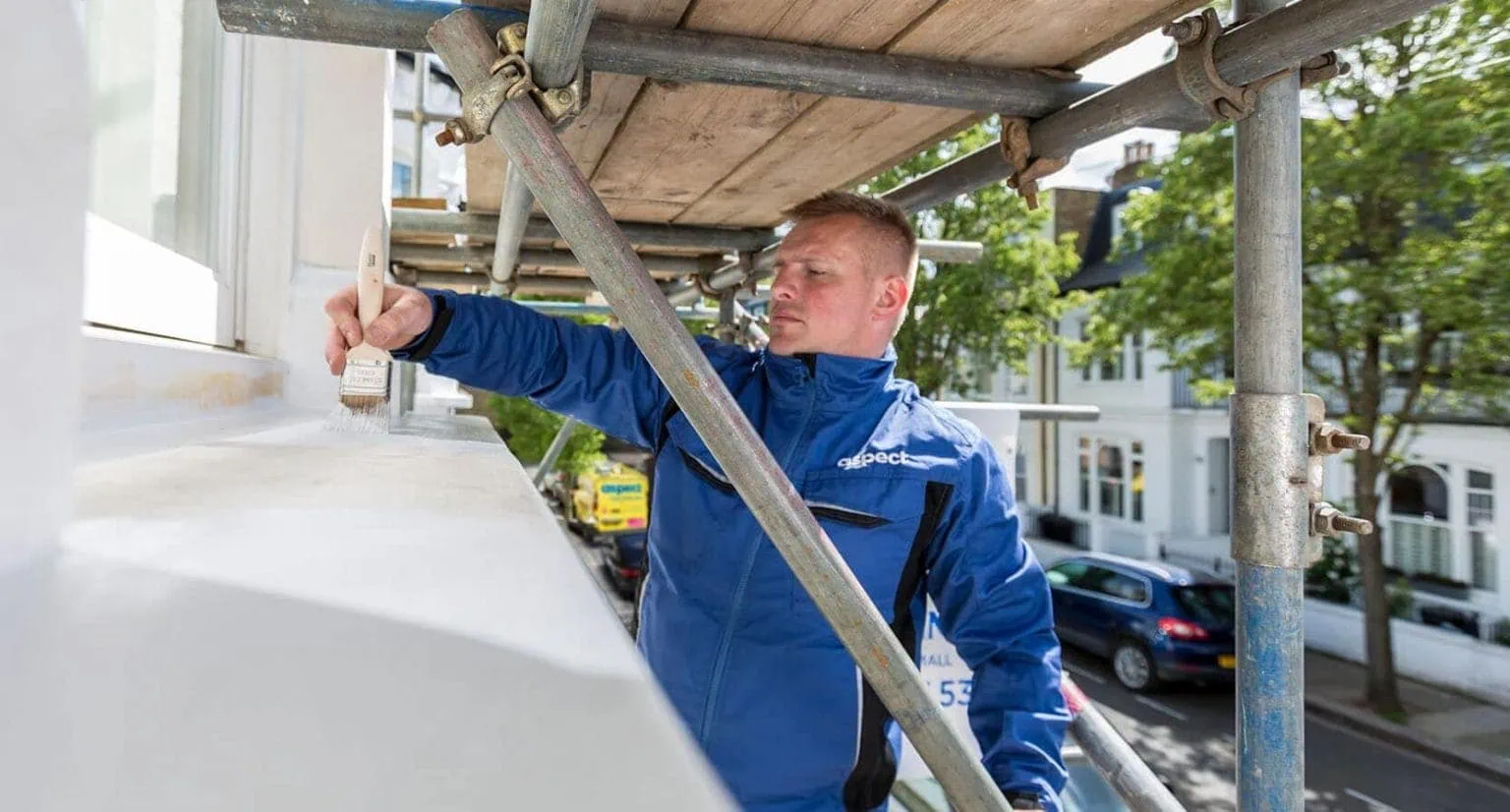How Do You Paint The Outside Of A House, advice from trade experts
Want to give your home a new lease of life? You may want to think about repainting it. Exterior house painting is a great way to give it a cosmetic boost, but more importantly, it helps to protect the brickwork, render and woodwork from the elements.
Before you decide to paint your house, be sure to check out this guide. We look at the signs it’s time to repaint the exterior, the best time of year for exterior painting and decorating, which paints are the best to use, how many coats you’ll need to apply, and whether or not it’s a good idea to do the work yourself.

When is the best time to paint a house?
If you’re in the South East of the UK, it’s best to paint the outside of your property between the months of April and September. Spring and summer are usually the best times, with warm, dry days that make conditions in London and the South East perfect for exterior house painting. Keep an eye on the forecast and aim for a period of dry weather over several days. Allow for the painting and drying time for at least a couple of coats.
Paints dry best in temperatures between 10 and 21C, and the process normally takes between 4 and 5 hours. Damp conditions will extend the curing time and affect its adherence. Manufacturer guarantees also tend to stipulate that you paint only in good weather, so if you paint in bad weather and get poor results, you won’t be able to claim back your money.
How often should I paint my property’s exterior?
Aspect recommend that you paint your house every 7-10 years, depending on a number of factors:
- Location – A house by the beach will need to be painted more often than one in the suburbs, as will a home in a more polluted area. That’s because wind-blown salt and chemical compounds in the air can cause higher rates of weathering.
- Nearby trees – Tree growth can affect the amount of light that reaches the property, making for a damp environment that causes the paint to deteriorate. The paintwork may even blister and crack if water finds its way under the existing layers.
- Direct sunlight – You want some sun to dry out the rain, but conversely, constant UV rays can cause the paintwork to fade. Additionally, intense changes in temperature can lead to a process of contraction and expansion, causing some paints to crack.
- Climbing plants – Certain plants such as ivy like to creep along your walls. These often feature tiny offshoots that can dig into the paintwork and even damage the render underneath.
- Weather patterns – Storms, rain and hail will naturally take their toll on the paintwork. The most common issue in the UK is the presence of moisture.
Paints that were applied in the right conditions, and on a surface that was cleaned and primed, will typically last longer than paints that didn’t receive the same care.
Some exterior paints come with an extensive guarantee (sometimes up to 15 years), but we’d advise painting your house before this time is up. That way your home will stay looking good and there won’t be a time when it’s unprotected from the elements.

Book an exterior house painter
Our painters and decorators are available for domestic and commercial work.
- Free fixed-price quotes available
- Trade-rated materials for lasting quality
- Knowledge and advice you can trust
- Experienced and accredited decorators
- A high-quality finish every time
How many coats do I need to apply to the exterior?
When it comes to exterior house painting, you’ll usually need to apply two coats. If just one coat of paint is applied, the results may be less effective due to poor coverage. You’ll likely be unsatisfied with its quality and need to get your house painted again sooner than expected.
A second coat will seal in the colour and maximise the lifespan of the painting job. As a result, the price to paint your home in multiple coats will be lower than applying just one coat more frequently.
Can I paint over existing paintwork?
According to our expert painters, the answer is yes – you can sometimes paint straight over the existing paintwork. But we’d only advise doing this if the original paint is in good condition and you simply want to change the colour.
The old paint usually needs to be removed if it’s peeling or flaking; we’d typically use a wire brush or jet washer to do this part of the job, sand the surface down, and fill in any cracks. A primer should be applied before adding the new coat of paint.
The success of your exterior house painting project also depends on the condition of what you’re painting. Painting over rotting wood, or bricks with mortar issues, won’t magically fix those problems. In most cases, underlying damage will only cause the paint to fail more quickly. You should only paint onto a stable base.
What colour should I paint my house?
From brilliant whites to natural greens and earthy reds, there are so many colours to choose from. You can always find a colour to suit the style you want for the exterior of your home.
In our experience, most people choose a light colour that gives the impression of a house being larger than it is. They often contrast this bright appearance with darker trims to create an appealing style that isn’t just a single block colour.
If you live in a conservation area, then you may have to contend with an Article 4 direction as part of the Town and Countryside Planning Act. This takes away permitted development rights, including the ability to choose the colour of your walls, trims, window frames, and even the front door.
Tip: Before you start painting, it’s worth checking to see if a preservation order is in place. If so, you’ll be expected to paint your home in the style of the surrounding properties. If you don’t, you’ll probably be asked to change it.
What type of paint is best for a house exterior?
We find that acrylic paints are the best choice for exterior house painting because of their elasticity. This means the paint can expand and contract when the temperature changes. They’re also washable, making painted surfaces easy to clean. We sometimes use masonry paints on the trims because they’re waterproof and protect against pollution.
The type of paint you use may depend on your budget. We recommend using Dulux for good, affordable paints, or Farrow & Ball for their superior quality.
What are the signs I need to repaint my house?
- Cracked paintwork – Cracks and blisters are key signs that your exterior paintwork is failing. Once this happens, the surface below will be exposed, making it more vulnerable to rain and potential infestations.
- Moss and algae – These must be removed before any paints can be applied. Because moss thrives in damp conditions, it can be an indicator of moisture issues.
- Caulking problems – ‘Caulk’ is a joint sealer that’s typically applied to keep out water, insects and cold draughts. It can peel or flake off the property, in which case it may be time to give your property’s exterior the maintenance it deserves.
- Large cracks in walls – If there are extensive cracks along the outside of your property, it’s unlikely that it’s just the paintwork affected. Instead, there might be an issue with the property’s foundations.
- You’re selling up – Exterior house painting is a great way to boost buyer interest when it’s time to sell up. In fact, a study by Dulux suggests that over 90% of house hunters are more likely to view a home that’s received a fresh coat of paint.
Should I paint my house myself or hire an expert?

Above: One of our painters working safely on a scaffold.
There’s nothing to say you can’t do the work yourself, but it will be labour intensive and there could be problems along the way. How long it takes depends on the size of your property as well as your skill level. We recommend that you only do the work yourself if you’ve got the right knowledge and experience, and have successfully painted homes before.
There’s also the issue of safety to consider. In most cases, exterior house painting involves working at height. We don’t recommend getting on a ladder to do the work; you’ll be holding on with one hand, whilst also holding a paintbrush and paint tin! Instead, it’s usually best to get scaffolding erected so you can access high areas from a relatively safe platform.
Why not book with us to enjoy the peace of mind that comes with using an expert painter and decorator? Our specialists have years of experience in the extensive prep work needed, and know exactly how to mitigate the risks of working at height. They also paint commercial properties (including offices) in London and the Home Counties.
Was this article helpful?
Think we could improve this article? Please let us know